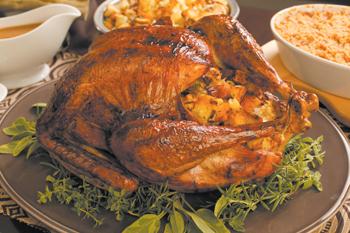 About 50 percent of all turkeys produced in the United States last year came from four states: Minnesota, North Carolina, Arkansas and Missouri. Minnesota is responsible for 18 percent of all turkey production. North Carolina is No. 2, producing 14 percent of turkeys, according to the U.S. Department of Agriculture. While Minnesota had the edge on the number of turkeys, the value of turkeys produced in North Carolina was greater. At $848.8 million, North Carolina’s turkeys are worth about $10 million more than Minnesota’s.
About 50 percent of all turkeys produced in the United States last year came from four states: Minnesota, North Carolina, Arkansas and Missouri. Minnesota is responsible for 18 percent of all turkey production. North Carolina is No. 2, producing 14 percent of turkeys, according to the U.S. Department of Agriculture. While Minnesota had the edge on the number of turkeys, the value of turkeys produced in North Carolina was greater. At $848.8 million, North Carolina’s turkeys are worth about $10 million more than Minnesota’s.
Butterball, LLC, is one of America’s most iconic brands. Headquartered in Garner, North Carolina, Butterball is the nation’s largest producer of turkeys. The company owns and operates farms, processing facilities and support offices. Butterball opened its newest processing plant in nearby Raeford three years ago with an initial investment of $30 million.
The company recently added another $20 million to expand the Raeford operation, including a new production line for turkey bacon products. “When Butterball opened the Raeford plant in 2015, we knew we had a great workforce and a state-of-the-art facility, but the overall operation has exceeded our expectations,” said Barry Gum, Butterball chief financial officer. “We are a proud North Carolina-based company and are excited about the opportunity to continue to grow our business within the state.”
In 2015, then-Gov. Pat McCrory said the plant would create 367 jobs in Hoke County over three years. The company expects to add an additional 50 jobs to its Hoke County workforce. “I think when we had that first announcement ... we were talking about the employees being close to 500 or 600 associates at some point in time,” said Mike Bliss, vice president of operations.
Plant production climbed to 130 million pounds of turkey in 2017. Data compiled by Iowa State University’s Agricultural Marketing Resource Center found that growth in poultry consumption has outpaced that of red meat over the past decade and has grown twentyfold since 1910. Thanksgiving and Christmas holidays typically feature traditional turkey feasts.
The history of the Thanksgiving turkey is a mystery. Historians have different theories. Thanks to letters and records kept by early American settlers, we know that when the pilgrims sat down to dine with the Wampanoag Indians, beef and fowl were on the menu. This historical meal would later become known as the first Thanksgiving.
Although historians cannot say for sure which types of fowl were served that day, a letter written by pilgrim Edward Winslow mentions a turkey hunting trip before the meal. The wild turkey is native to North America. Benjamin Franklin claimed this made the turkey a more suitable national bird than the bald eagle. Not everyone agreed with Franklin, and the bald eagle became the national emblem for the United States in 1782. The bald eagle may be America’s bird 364 days a year, but the turkey has one day all to itself – Thanksgiving.

 How to resolve AdBlock issue?
How to resolve AdBlock issue? 








